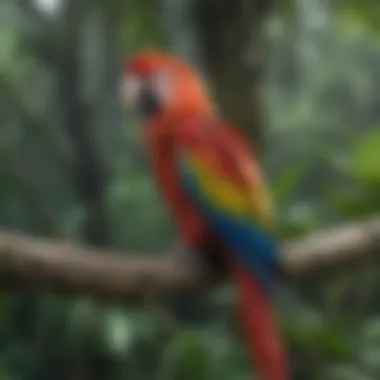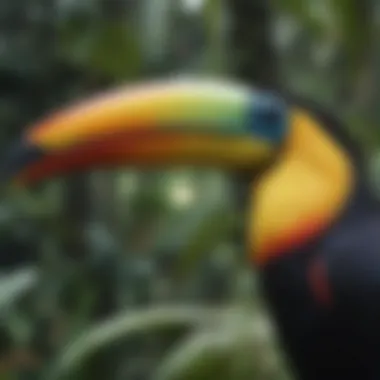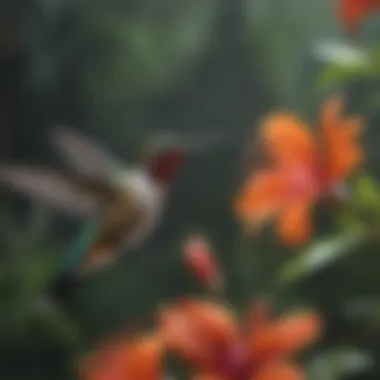Unveiling the Diverse Avian Wonders of the Amazon Rainforest


Animal Species Profile
As we delve into the rich birdlife of the Amazon Rainforest, we are immediately captivated by the diverse array of avian species that call this lush ecosystem home. From the iconic macaws with their striking colorful plumage to the elusive birds of prey that soar high above the canopy, the Amazon forest is a treasure trove of avian biodiversity waiting to be explored.
Introduction to the animal species
Each bird species in the Amazon Rainforest carries its own unique charm and significance. The macaws, known for their vibrant feathers and raucous calls, symbolize the splendor of this jungle paradise. On the other hand, the birds of prey, with their keen hunting skills and stealthy movements, embody the essence of wildness in this intricate ecosystem.
Physical characteristics and appearance
The physical characteristics of these avian creatures are a testament to the evolutionary marvels that have shaped their survival. The macaws boast a rainbow of colors adorning their feathers, not only for aesthetic appeal but also as a form of camouflage amidst the dense foliage. Conversely, birds of prey possess sharp talons and keen eyesight, enabling them to hunt with precision in the intricate maze of the rainforest.
Natural habitat and distribution
These avian wonders have finely tuned their existence to thrive in the unique habitats of the Amazon Rainforest. The macaws are often found in the towering trees of the canopy, where they nest and forage for fruits and nuts. Birds of prey, on the other hand, dominate the skies, using their keen vision to hunt amidst the tangled undergrowth of the forest floor.
Behavior and social interactions
Observing the behavior and social interactions of these birds offers a glimpse into the complex dynamics of the Amazon avifauna. Macaws exhibit intricate courtship rituals, highlighting their strong social bonds and communication skills. In contrast, birds of prey are solitary hunters, showcasing their independence and adaptability in navigating the challenges of the rainforest environment.
Introduction to the Amazon Rainforest
The Amazon Rainforest stands as a monumental natural masterpiece, unrivaled in its ecological significance and unparalleled biodiversity. This article embarks on a captivating exploration of the diverse birdlife nestled within this verdant expanse, shedding light on their crucial role in maintaining the delicate balance of this ecosystem. Venturing into the heart of the Amazon unveils a realm where vibrant feathers and melodic calls intertwine with the lush green canopy, creating a captivating symphony of avian life.
Overview of the Amazon Rainforest
Location and Size
Nestled primarily within South America, the Amazon Rainforest sprawls across approximately 5.5 million square kilometers, embracing a staggering array of habitats and microclimates. Its sheer vastness encompasses multiple countries, including Brazil, Peru, Colombia, and others, making it a biodiversity hotspot of global significance. This expanse teems with life, providing a sanctuary for countless plant and animal species, each one playing a vital role in the intricate web of life that defines this rainforest ecosystem.
Biodiversity Hotspot
The Amazon Rainforest is universally recognized as a biodiversity hotspot, harboring a mesmerizing array of flora and fauna found nowhere else on Earth. Its unparalleled richness in species diversity has earned it a hallowed status among ecologists and conservationists. The interwoven tapestry of life within this dense canopy is a testament to the intricate ecological relationships that have evolved over millennia, underscoring the Amazon's irreplaceable value in preserving biological wealth.
Impact of Deforestation
Tragically, the Amazon Rainforest faces the grave threat of rampant deforestation, driven by diverse forces ranging from agricultural expansion to illegal logging. This relentless destruction jeopardizes not only the vast biodiversity sheltered within these forests but also the vital ecosystem services they provide. The far-reaching consequences of deforestation extend beyond regional boundaries, impacting global climate patterns and biodiversity levels, underscoring the urgent need for concerted conservation efforts to safeguard this ecological treasure.
Importance of the Amazon Rainforest
Carbon Sequestration
A fundamental ecological function of the Amazon Rainforest lies in its role as a carbon sink, sequestering vast amounts of carbon dioxide from the atmosphere and helping mitigate the impacts of climate change. The dense vegetation of the rainforest acts as a formidable carbon reservoir, playing a crucial part in regulating the Earth's climate system and fostering global carbon balance.


Climate Regulation
Beyond its carbon sequestration capacity, the Amazon Rainforest exerts a profound influence on regional and global climates, modulating rainfall patterns and atmospheric circulation. The transpiration process of the forest's canopy significantly contributes to cloud formation and precipitation, engendering a delicate climatic equilibrium that sustains both local ecosystems and distant regions around the world.
Cultural Significance
For countless indigenous communities inhabiting the Amazon basin, the rainforest holds profound cultural and spiritual significance, weaving a tapestry of traditional knowledge, rituals, and beliefs intrinsically connected to the land. The forest serves as a living heritage, embodying the ancestral wisdom and cultural identity of indigenous peoples, underscoring the crucial link between human societies and the natural world.
Bird Species in the Amazon Rainforest
In this section, we will delve into the captivating world of bird species thriving in the Amazon Rainforest. The avian diversity in this lush ecosystem plays a pivotal role in maintaining ecological balance and biodiversity. From vibrant macaws to majestic birds of prey, the Amazon Rainforest boasts a rich array of birdlife that mesmerizes enthusiasts and researchers alike. Understanding these bird species is crucial for appreciating the intricate connections within this vibrant ecosystem and the importance of conservation efforts.
Diversity of Birdlife
Macaws and Parrots
Macaws and parrots, with their vivid plumage and gregarious nature, are icons of the Amazon Rainforest's avifauna. These colorful birds not only contribute to the visual splendor of the forest but also play essential roles as seed dispersers and pollinators. Their ability to mimic sounds and vocalize adds a charismatic charm to the rainforest soundscape, highlighting their significance in maintaining the forest's vitality.
Toucans and Aracaris
Toucans and aracaris, with their distinctively large and colorful bills, are another group of avian wonders thriving in the Amazon Rainforest. These fruit-loving birds play vital roles in seed dispersal, contributing to the regeneration of plant species within the forest. Their unique beak structures and feeding behaviors showcase evolutionary adaptations that allow them to thrive in this diverse ecosystem.
Hummingbirds
Hummingbirds, known for their iridescent plumage and hovering flight patterns, are agile pollinators crucial for maintaining floral diversity in the Amazon Rainforest. Their specialized feeding mechanisms and rapid wingbeats enable them to access nectar from a variety of flowers, highlighting their ecological importance as key pollinators in this biodiverse habitat.
Birds of Prey
Harpy Eagle
The Harpy Eagle, known for its powerful build and keen hunting abilities, symbolizes the apex predator in the Amazon Rainforest. With its striking appearance and large talons, the Harpy Eagle plays a crucial role in regulating prey populations, contributing to the ecosystem's balance. However, due to habitat loss and human activities, these majestic raptors face conservation challenges that warrant urgent attention.
Crested Eagle
The Crested Eagle, with its impressive crest and stealthy hunting tactics, is a lesser-known but essential predator in the Amazon Rainforest. These eagles exhibit specialized behaviors that allow them to target specific prey species within the forest, showcasing the complexities of avian adaptations in this dynamic ecosystem.
Black Hawk-Eagle
The Black Hawk-Eagle, with its agile flight and sharp talons, embodies the stealth and precision of avian predators found in the Amazon Rainforest. These raptors play critical roles in controlling the populations of small mammals and birds, contributing to the intricate food web dynamics within the forest. Conservation efforts focusing on protecting these birds of prey are essential for maintaining ecosystem health and balance.
Endemic and Rare Species
Amazonian Umbrellabird


The Amazonian Umbrellabird, with its unique appearance and behaviors, represents an endemic species that adds to the allure of the Amazon Rainforest. These umbrella-shaped crested birds contribute to seed dispersal and forest regeneration, highlighting their ecological significance. Despite their charismatic presence, habitat loss and deforestation threaten the survival of these rare avian wonders, underscoring the urgency of conservation actions.
Black-spotted Bare-eye
The Black-spotted Bare-eye, with its secretive nature and distinctive markings, showcases the biodiversity of rare birds inhabiting the Amazon Rainforest. These cryptic birds play essential roles in maintaining insect populations and ecological balance within the forest understory. Understanding the habitat requirements and behaviors of these elusive species is crucial for developing effective conservation strategies to protect their fragile populations.
Pied Puffbird
The Pied Puffbird, with its pudgy build and distinctive coloration, adds charm to the avifauna of the Amazon Rainforest. These insect-eating birds exhibit unique vocalizations and nesting strategies, highlighting the diverse adaptations shaped by the rainforest environment. Conservation efforts targeting the protection of the Pied Puffbird's habitats are essential for preserving the rich biodiversity and ecological interactions that define this vibrant ecosystem.
Adaptations and Behaviors
In the expansive and biodiverse ecosystems of the Amazon Rainforest, the adaptations and behaviors of its avian inhabitants play a crucial role in their survival and interactions within this intricate environment. Understanding how bird species have evolved specific traits to thrive in the challenging conditions of the rainforest provides valuable insights into the intricate web of life that shapes this ecosystem.
Specialized Adaptations
Beak Shapes and Sizes
Exploring the varied beak shapes and sizes within Amazonian bird species unveils a fascinating array of adaptations tailored to their dietary requirements and foraging strategies. From the robust and powerful beaks of birds of prey like the Harpy Eagle to the slender and elongated beaks of hummingbirds, each adaptation serves a specific purpose in maximizing feeding efficiency and exploiting available food sources. The diversity in beak shapes and sizes showcases the evolutionary flexibility of these birds and highlights how natural selection has honed these structures to perfection in the Amazon Rainforest.
Camouflage Techniques
The camouflage techniques employed by Amazonian birds are essential for survival amidst the lush greenery of the rainforest. From cryptic plumage patterns that blend seamlessly with the foliage to the mimicry of tree bark textures, these adaptations aid in evading predators and hunting unseen. Camouflage not only provides protection but also increases the effectiveness of foraging by allowing birds to approach prey unnoticed, showcasing nature's ingenious solutions for survival in a competitive environment.
Migratory Patterns
The migratory patterns of certain bird species in the Amazon Rainforest reveal a fascinating aspect of their behaviors and survival strategies. Understanding the seasonal movements of migratory birds sheds light on their need to seek specific habitats for breeding, feeding, or shelter during different times of the year. Migration ensures access to essential resources unavailable in their breeding grounds, demonstrating the adaptive nature of these avian travelers in response to environmental changes.
Courtship and Nesting Behavior
Observing the courtship and nesting behavior of Amazonian birds provides a glimpse into the intricacies of their social interactions and reproductive success within the rainforest setting. From elaborate courtship displays to intricate mating rituals, these behaviors not only strengthen pair bonds but also secure the next generation's survival through effective parental care.
Elaborate Displays
Elaborate courtship displays serve as signals of fitness and compatibility among potential mates, allowing birds to assess the quality of their partners and ensure successful reproduction. These displays range from dazzling aerial acrobatics to intricate dances, showcasing the artistic and physical prowess of the avian performers in their quest for suitable mates.
Mating Rituals
Mating rituals in Amazonian birds often involve complex rituals and vocalizations that reinforce pair bonds and synchronize breeding efforts. From synchronized duets to elaborate gift offerings, these rituals enhance communication and coordination between mates, ensuring reproductive success and the continuity of their species in the dynamic rainforest environment.
Parental Care
The provision of parental care among Amazonian bird species reflects a deep investment in offspring survival and development. From shared incubation duties to food provisioning and nest protection, parental care behaviors contribute to the growth and well-being of the next generation. The dedication and sacrifices made by parent birds underscore the importance of familial bonds and the transmission of essential skills for young birds to thrive in their challenging surroundings.


Conservation and Threats
Conservation and threats are pivotal aspects of this article, shedding light on the critical balance between preserving biodiversity and confronting challenges within the Amazon Rainforest. Emphasizing the fragility of the ecosystem, the section delves into the intricate web of factors threatening the rich birdlife. By comprehensively analyzing these dynamics, readers gain a profound understanding of the urgent need for conservation efforts to safeguard the Amazon's avian treasures.
Habitat Loss and Fragmentation
Deforestation
Deforestation stands as a pressing concern, dramatically altering the landscape and disrupting the delicate harmony of the rainforest. The rampant clearing of trees for agriculture and urbanization poses a severe threat to bird habitats, endangering numerous species. The devastating impact of deforestation reverberates throughout the ecosystem, leading to habitat loss, species displacement, and reduced biodiversity. Understanding the drivers behind deforestation is crucial to formulating effective conservation strategies that address this pervasive challenge.
Human Encroachment
Human encroachment represents another significant threat to the Amazon's birdlife, as human activities encroach upon previously untouched territories. Urban expansion, infrastructure development, and resource extraction bring humans into direct conflict with the natural habitats of birds, resulting in habitat degradation and fragmentation. The encroachment of human settlements further exacerbates the challenges faced by avian populations, underscoring the urgency of conservation actions to mitigate these detrimental effects.
Illegal Wildlife Trade
The illicit trade in wildlife poses a grave threat to the Amazon's avifauna, driving unsustainable exploitation of bird species for commercial gain. Illegal wildlife trade not only diminishes populations through poaching and trafficking but also disrupts ecological balance and threatens the survival of vulnerable species. Combatting this illicit trade requires a multi-faceted approach that combines law enforcement, community engagement, and awareness-building to protect the diverse bird species inhabiting the rainforest.
Conservation Efforts
Protected Areas
Establishing and maintaining protected areas within the Amazon Rainforest is essential for preserving critical habitats and safeguarding vulnerable bird species. These designated zones provide a sanctuary for avian diversity, enabling populations to thrive without the threat of immediate human encroachment. By designating areas off-limits to destructive activities, protected areas serve as vital refuges for biodiversity, contributing to the long-term conservation of the rainforest's birdlife.
Community-Based Initiatives
Community-based initiatives play a pivotal role in engaging local stakeholders in conservation efforts and fostering a sense of stewardship over natural resources. By empowering communities to take an active role in protecting bird habitats and promoting sustainable practices, these initiatives create a shared sense of responsibility for environmental preservation. Collaborative conservation projects that involve local residents not only benefit avian populations but also contribute to the well-being of indigenous communities and the long-term sustainability of conservation efforts.
Research and Monitoring
Investing in research and monitoring initiatives is essential for gathering valuable data on bird populations, behaviors, and threats within the Amazon Rainforest. By studying avian ecology, tracking migration patterns, and assessing the impacts of environmental changes, researchers can better inform conservation strategies. Continuous monitoring enables scientists and conservationists to adapt their approaches, identify emerging threats, and track the effectiveness of conservation measures, ensuring the ongoing protection of the Amazon's rich birdlife.
Conclusion
In wrapping up the exploration of the rich birdlife of the Amazon Rainforest, it becomes evident that the avifauna of this region holds immense ecological significance. The diverse bird species act as vital indicators of the rainforest's overall health and robustness. Understanding and preserving the unique avian biodiversity is crucial not only for the birds themselves but also for the entire ecosystem's balance and stability. By delving into the complex web of interactions between birds and their environment, we gain a deeper appreciation for the delicate harmony that sustains life in the Amazon Rainforest.
Appreciating Amazonian Avifauna
Biodiversity Conservation
Diving into the realm of biodiversity conservation within the Amazon Rainforest unveils a multifaceted approach to safeguarding the rich birdlife and its habitat. The conservation efforts focus on preserving the intricate mosaic of avian species, ensuring the long-term viability of their populations. Emphasizing the significance of protecting not just individual species but the entire ecosystem highlights the interconnectedness of all life forms in the rainforest. Biodiversity conservation serves as a pillar of stewardship, aiming to secure a future where the melodious tunes of Amazonian birds continue to resonate through the lush canopy.
Ecotourism Opportunities
Exploring the realm of ecotourism opportunities within the Amazon Rainforest opens up avenues for sustainable engagement with this unique avian paradise. By promoting responsible tourism practices, visitors can immerse themselves in the wonders of the rainforest while contributing to its preservation. Ecotourism provides a platform for raising awareness about the importance of biodiversity and conservation, fostering a sense of awe and respect for the natural world. The potential for ecotourism to drive local economies sustains both the welfare of communities and the integrity of the Amazon Rainforest, creating a harmonious coexistence between humans and birds.
Personal Responsibility
Underlying the exploration of Amazonian avifauna is the concept of personal responsibility, urging individuals to take proactive steps towards conservation and sustainability. Each person plays a role in the preservation of biodiversity, from reducing carbon footprints to supporting ethical wildlife practices. Embracing personal responsibility fosters a sense of ownership and empowerment in safeguarding the natural heritage of the Amazon Rainforest. By cultivating a culture of respect and accountability towards the environment, individuals contribute to the collective efforts in preserving the irreplaceable birdlife of this extraordinary ecosystem.







